#WR 124
Text
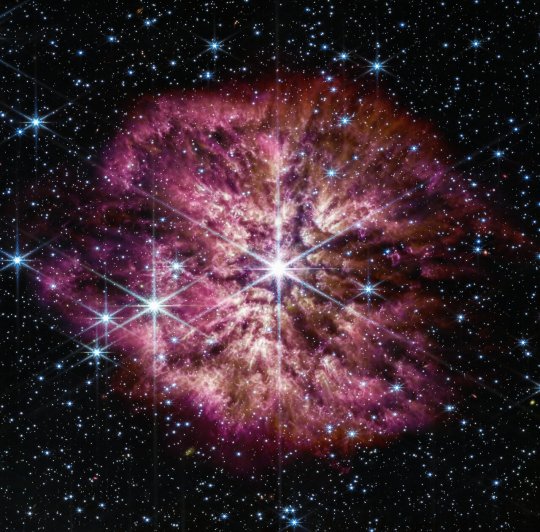
Crisp Death
127 notes
·
View notes
Text
Wolf-Rayet star 124 and its nebula
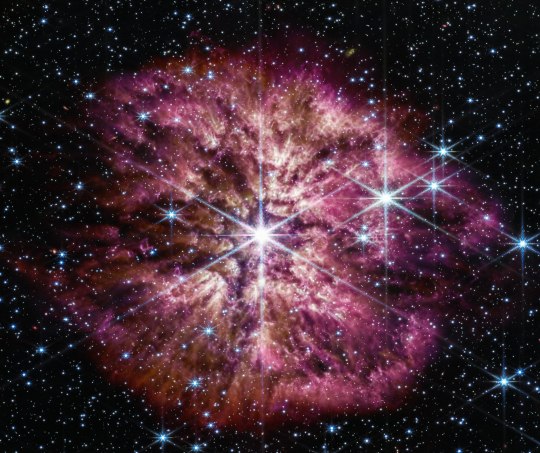
Wolf-Rayet stars are among the most luminous and massive - and rarest to see, because they live such brief lives. this photo by NASA’s Webb Space Telescope reveals unprecedented details around the star WR 124, such as the 100-billion-mile-wide glowing gas blobs it's ejecting at faster than 100,000 mph
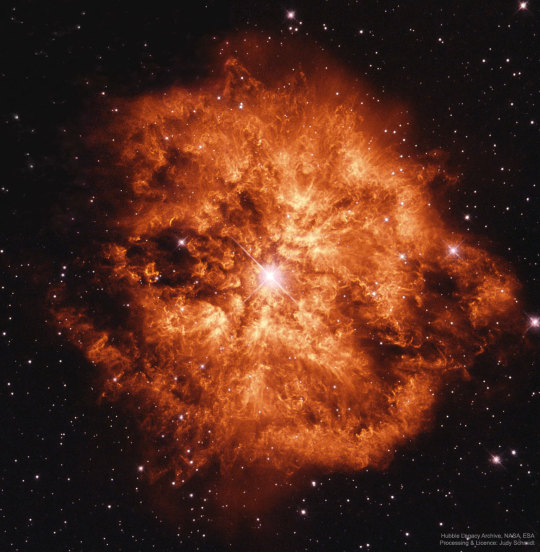
(older photo by the Hubble Space Telescope)
Wolf-Rayet stars are in the process of casting off their outer layers, resulting in their characteristic halos of gas and dust. WR 124 is 30 times the mass of our Sun and has shed 10 Suns’ worth of material so far, with much more to come before it explodes in a supernova explosion
supermassive stars race through their lifecycles, and only some of them go through a brief Wolf-Rayet phase before going supernova, making Webb’s detailed observations of this rare phase invaluable - such cast-off material later gathers to form planets and new stars, and serves as a platform for molecules to form and clump together, including the building blocks of life
44 notes
·
View notes
Photo
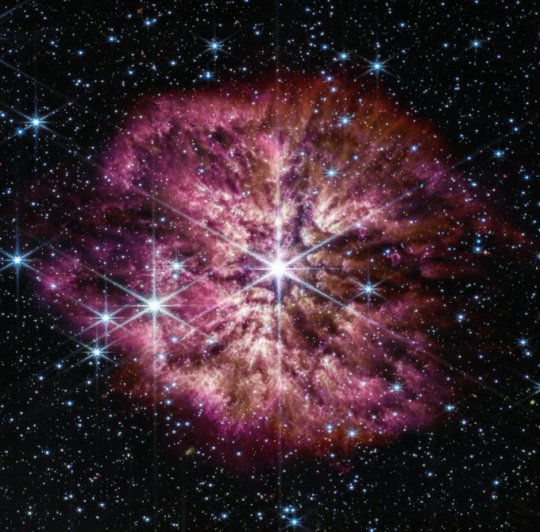
Webb Telescope
The rare sight of a Wolf-Rayet star – among the most luminous, most massive, and most briefly detectable stars known – was one of the first observations made by NASA’s James Webb Space Telescope in June 2022. Webb shows the star, WR 124, in unprecedented detail with its powerful infrared instruments. The star is 15,000 light-years away in the constellation Sagitta.
Massive stars race through their lifecycles, and only some of them go through a brief Wolf-Rayet phase before going supernova, making Webb’s detailed observations of this rare phase valuable to astronomers. Wolf-Rayet stars are in the process of casting off their outer layers, resulting in their characteristic halos of gas and dust. The star WR 124 is 30 times the mass of the Sun and has shed 10 Suns’ worth of material – so far. As the ejected gas moves away from the star and cools, cosmic dust forms and glows in the infrared light detectable by Webb.
#Webb Telescoe#James Webb Space Telescope#Wolf-Rayet star#WR 124#Sagitta#NASA#nasa photos#nasa picture of the day#space#beauty#beautiful
25 notes
·
View notes
Text
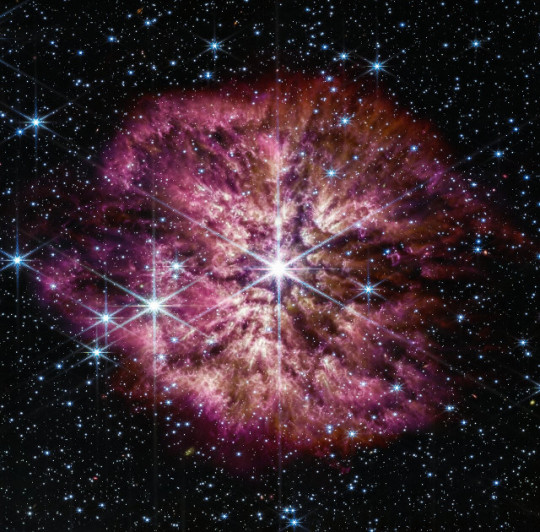
An image captured by the James Webb Space Telescope shows the star WR 124 and the surrounding nebula in never-before-seen detail. This is a case where a star is nearing the end of its life, which could culminate in a supernova. For this reason, astronomers have been keeping an eye on WR 124 for years with various instruments and it was among Webb's first observation targets in June 2022. The very powerful stellar wind typical of so-called Wolf-Rayet stars caused the loss of this star's outer layers, which formed the nebula that surrounds it. Its details have now been captured in the breathtaking image thanks to Webb's NIRCam and MIRI instruments to better understand the processes taking place before the possible supernova or another type of death.
3 notes
·
View notes
Text
James Webb Space Telescope Captures Stunning Image of WR 124 star
On March 14, 2023, The James Webb Space Telescope, NASA's latest and most advanced observatory, has released an awe-inspiring image of the star WR 124, located about 15,000 light-years away in the constellation Sagittarius. Read full article here

16 notes
·
View notes
Text


Barbie | Oppenheimer
1 note
·
View note
Text
Sakura to Supernova
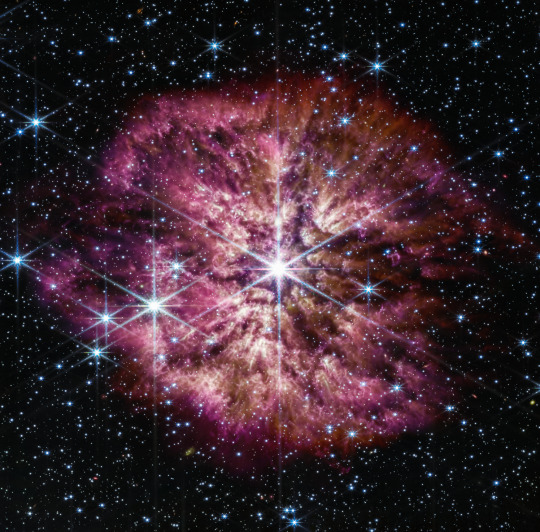
This rare sight is a super-bright, massive Wolf-Rayet star. Calling forth the ephemeral nature of cherry blossoms, the Wolf-Rayet phase is a fleeting stage that only some stars go through soon before they explode.
The star, WR 124, is 15,000 light-years away in the constellation Sagittarius. It is 30 times the mass of the Sun and has shed 10 Suns worth of material – so far. As the ejected gas moves away from the star and cools, cosmic dust forms and glows in the infrared light detectable by NASA's James Webb Space Telescope.
The origin of cosmic dust that can survive a supernova blast is of great interest to astronomers for multiple reasons. Dust shelters forming stars, gathers together to help form planets, and serves as a platform for molecules to form and clump together, including the building blocks of life on Earth.
Stars like WR 124 also help astronomers understand the early history of the universe. Similar dying stars first seeded the young universe with heavy elements forged in their cores – elements that are now common in the current era, including on Earth.
The James Webb Space Telescope opens up new possibilities for studying details in cosmic dust, which is best observed in infrared wavelengths of light. Webb’s Near-Infrared Camera balances the brightness of WR 124’s stellar core and the knotty details in the fainter surrounding gas. The telescope’s Mid-Infrared Instrument reveals the clumpy structure of the gas and dust nebula of the ejected material now surrounding the star.
Make sure to follow us on Tumblr for your regular dose of space!
5K notes
·
View notes
Text
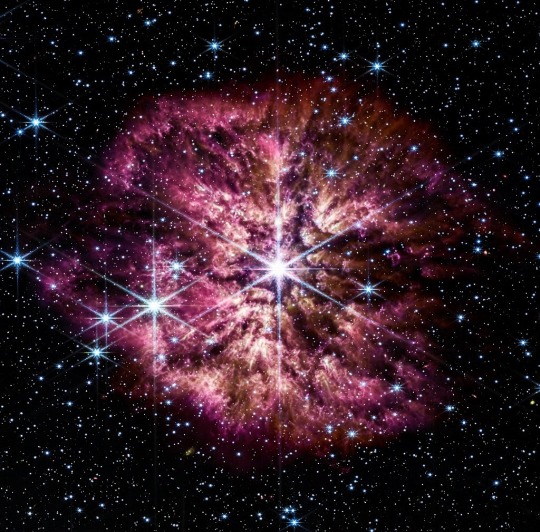
SPACEMAS DAY 9 ✨🪐🌎☄️☀️🌕
Driven by powerful stellar winds, the expanding gas and dust frame the hot, luminous star Wolf-Rayet 124 in this sharp infrared view. The 6-spike star pattern is characteristic, taken with the 18 hexagonal mirrors of the James Webb Space Telescope. About 15,000 light-years away toward the pointed northern constellation Sagittarius, WR 124 has over 30 times the mass of the Sun. Produced in a brief and rarely spotted phase of massive star evolution in the Milky Way, this star's turbulent nebula is nearly 6 light-years across. WR 124's impending stellar death will be a supernova explosion and any dusty interstellar debris that survives the supernova will influence the formation of future generations of stars.
Image Credit: NASA
#astronomy#space#science#universe#spacemas#day 9#nebula#star#supernova#jwst#james webb space telescope#follow#like#reblog#the first star#the first starr#thefirststar#thefirststarr#nasa#apod#tumblr#blog#space blog
74 notes
·
View notes
Text

Did you know NASA makes their astrophotography open source? They're one of my favorite resources. Since I started fundraising for my Palestinian friend I haven't looked at using them as much, but I'm still trying to mix these beautiful photos into my designs occasionally. This James Webb photo shows the Wolf–Rayet star WR 124 and the nebula M1–67. The above design can be found HERE. Some examples (shirts, sticker, acrylic block, notebook and pin):





As usual ALL PROCEEDS from my shop go to my Palestinian best friend to help him support his girlfriend in remaining safely in America until things calm down and to help his other loved ones around the Levant who are being hurt directly and/or financially by the attacks on Gaza, the raids in the West Bank and the collateral damage in surrounding countries. He will donate anything his family doesn't need to the Palestinian charities he works with.
It turns out that Redbubble collections cap out at 100 products, so I have temporarily removed my handful of products not related to Palestine and from now on I will dedicate my whole shop to this. My designs can be found here on my main page.
Here's one other astrophotography design I have in my collection:

Thank you to everyone who has helped out so far!
#palestine#free palestine#gaza#free gaza#social justice#save palestine#فلسطين#gaza strip#decolonisation#colonialism#human rights#palestine art#art#palestinian solidarity#art for palestine#astrophotography#astronomy#nasa#stickers#i stand with palestine
45 notes
·
View notes
Photo

2023 March 18
Wolf-Rayet 124
Image Credit: NASA, ESA, CSA, STScI, Webb ERO Production Team
Explanation: Driven by powerful stellar winds, expanding shrouds of gas and dust frame hot, luminous star Wolf-Rayet 124 in this sharp infrared view. The eye-catching 6-spike star pattern is characteristic of stellar images made with the 18 hexagonal mirrors of the James Webb Space Telescope. About 15,000 light-years distant toward the pointed northern constellation Sagitta, WR 124 has over 30 times the mass of the Sun. Produced in a brief and rarely spotted phase of massive star evolution in the Milky Way, this star's turbulent nebula is nearly 6 light-years across. It heralds WR 124's impending stellar death in a supernova explosion. Formed in the expanding nebula, dusty interstellar debris that survives the supernova will influence the formation of future generations of stars.
∞ Source: apod.nasa.gov/apod/ap230318.html
86 notes
·
View notes
Text
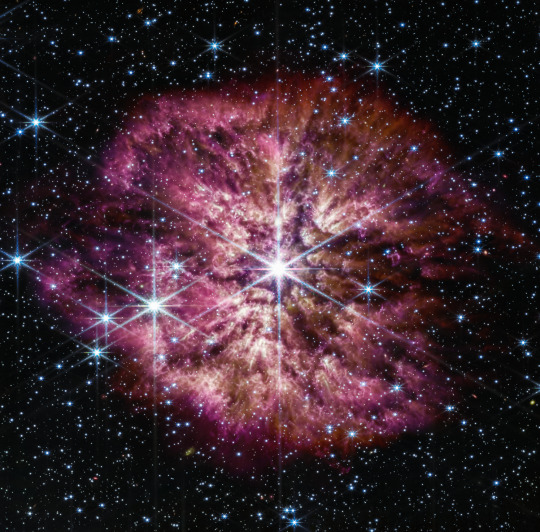
WR 124 (Wolf Rayet 124) in the constellation Sagitta; 2023
#supernova#stars#space#james webb space telescope#luminous#cosmos#cosmic#celestial#constellations#space dust#deep space#astrophotography#nebula#astral#astro#beautiful#beauty#escape#pretty#spiritual#photography#pink#purple#mystical#mysterious#we are all connected#the unknown#planets#nasa#wolf rayet
103 notes
·
View notes
Text

Supernova in Hiding
98 notes
·
View notes
Photo

NASA’s Webb Telescope Captures Rarely Seen Prelude to Supernova A massive star on the cusp of death ejected huge volumes of hot gas into space. Webb’s Mid-Infrared Instrument revealed the structure of the material now surrounding the star. The rare sight of a Wolf-Rayet star – among the most luminous, most massive, and most briefly detectable stars known – was one of the first observations made by NASA’s James Webb Space Telescope in June 2022. Webb shows the star, WR 124, in unprecedented detail with its powerful infrared instruments. The star is 15,000 light-years away in the constellation Sagittarius. Massive stars race through their lifecycles, and only some of them go through a brief Wolf-Rayet phase before going supernova, making Webb’s detailed observations of this rare phase valuable to astronomers. Wolf-Rayet stars are in the process of casting off their outer layers, resulting in their characteristic halos of gas and dust. The star WR 124 is 30 times the mass of the Sun and has shed 10 Suns’ worth of material – so far. As the ejected gas moves away from the star and cools, cosmic dust forms and glows in the infrared light detectable by Webb. The origin of cosmic dust that can survive a supernova blast and contribute to the universe’s overall “dust budget” is of great interest to astronomers for multiple reasons. Dust is integral to the workings of the universe: It shelters forming stars, gathers together to help form planets, and serves as a platform for molecules to form and clump together – including the building blocks of life on Earth. Despite the many essential roles that dust plays, there is still more dust in the universe than astronomers’ current dust-formation theories can explain. The universe is operating with a dust budget surplus. Webb opens up new possibilities for studying details in cosmic dust, which is best observed in infrared wavelengths of light. Webb’s Near-Infrared Camera (NIRCam) balances the brightness of WR 124’s stellar core and the knotty details in the fainter surrounding gas. The telescope’s Mid-Infrared Instrument (MIRI) reveals the clumpy structure of the gas and dust nebula of the ejected material now surrounding the star. Before Webb, dust-loving astronomers simply did not have enough detailed information to explore questions of dust production in environments like WR 124 and whether the dust grains were large and bountiful enough to survive the supernova and become a significant contribution to the overall dust budget. Now those questions can be investigated with real data. Stars like WR 124 also serve as an analog to help astronomers understand a crucial period in the early history of the universe. Similar dying stars first seeded the young universe with heavy elements forged in their cores – elements that are now common in the current era, including on Earth. Webb’s detailed image of WR 124 preserves forever a brief, turbulent time of transformation, and promises future discoveries that will reveal the long-shrouded mysteries of cosmic dust. More About the Mission The James Webb Space Telescope is the world’s premier space science observatory. Webb will solve mysteries in our solar system, look beyond to distant worlds around other stars, and probe the mysterious structures and origins of our universe and our place in it. Webb is an international program led by NASA with its partners, ESA (European Space Agency), and CSA (Canadian Space Agency). MIRI was developed through a 50-50 partnership between NASA and ESA. NASA’s Jet Propulsion Laboratory led the U.S. efforts for MIRI, and a multinational consortium of European astronomical institutes contributes for ESA. George Rieke with the University of Arizona is the MIRI science team lead. Gillian Wright is the MIRI European principal investigator. Alistair Glasse with UK ATC is the MIRI instrument scientist, and Michael Ressler is the U.S. project scientist at JPL. Laszlo Tamas with UK ATC manages the European Consortium. The MIRI cryocooler development was led and managed by JPL, in collaboration with Northrop Grumman in Redondo Beach, California, and NASA’s Goddard Space Flight Center in Greenbelt, Maryland. Caltech manages JPL for NASA. IMAGE....The luminous, hot star called Wolf-Rayet 124 was imaged by NASA’s James Webb Space Telescope. Bright clumps of gas and dust appear like tadpoles swimming toward the star with tails streaming out behind them, blown back by the stellar wind. The surrounding nebula stretches about 10 light-years across. Credit: NASA, ESA, CSA, STScI, Webb ERO Production Team
34 notes
·
View notes
Text

Un'immagine catturata dal telescopio spaziale James Webb mostra la stella WR 124 e la nebulosa che la circonda in dettagli mai visti prima. Si tratta di un caso in cui una stella sta per raggiungere la fine della sua vita, che potrebbe culminare con l'esplosione in una supernova. Per questo motivo, gli astronomi stanno tenendo d'occhio WR 124 da anni con vari strumenti ed è stata tra i primi obiettivi di osservazione di Webb nel giugno 2022. Il potentissimo vento stellare tipico delle cosiddette stelle di Wolf-Rayet ha causato la perdita degli strati esterni di questa stella, che hanno formato la nebulosa che la circonda, i cui dettagli sono ora stati catturati nell'immagine mozzafiato grazie agli strumenti NIRCam e MIRI di Webb per capire meglio i processi in atto prima della possibile supernova o di un altro tipo di morte.
0 notes
Text
Compiled this for myself to print and annotate tomorrow if I get the chance. I would write this up properly, but I don't have that much time at the moment. Below is a list of citation on papers discussing how BMI is not a good measure for assessing eligibility for top surgery in transmasculine population
Perez-Alvarez IM, Zolper EG, Schwitzer J, Fan KL, Del Corral GA. Incidence of Complications in Chest Wall Masculinization for the Obese Female-to-Male Transgender Population: A Case Series. World J Plast Surg. 2021 May;10(2):14-24. doi: 10.29252/wjps.10.2.14. PMID: 34307093; PMCID: PMC8290439.
Stein MJ, Grigor E, Hardy J, Jarmuske M. Surgical and patient-reported outcomes following double incision and free nipple grafting for female to male gender affirmation: does obesity make a difference? J Plast Reconstr Aesthet Surg. 2021 Aug;74(8):1743-1751. doi: 10.1016/j.bjps.2020.12.004. Epub 2020 Dec 10. PMID: 33341390.
Rothenberg KA, Gologorsky RC, Hojilla JC, Tang A, Cohan CM, Beattie G, Yokoo KM. Gender-Affirming Mastectomy in Transmasculine Patients: Does Obesity Increase Complications or Revisions? Ann Plast Surg. 2021 Jul 1;87(1):24-30. doi: 10.1097/SAP.0000000000002712. PMID: 33559996; PMCID: PMC8936918.
Brownstone LM, DeRieux J, Kelly DA, Sumlin LJ, Gaudiani JL. Body Mass Index Requirements for Gender-Affirming Surgeries Are Not Empirically Based. Transgend Health. 2021 Jun 2;6(3):121-124. doi: 10.1089/trgh.2020.0068. PMID: 34414267; PMCID: PMC8363993.
Linsenmeyer WR, Garwood S. Patient-Centered Approaches to Using BMI to Evaluate Gender-Affirming Surgery Eligibility. AMA J Ethics. 2023 Jun 1;25(6):E398-406. doi: 10.1001/amajethics.2023.398. PMID: 37285293.
Hassan B, Schuster CR, Ascha M, Del Corral G, Fischer B, Liang F. Association of High Body Mass Index With Postoperative Complications After Chest Masculinization Surgery. Ann Plast Surg. 2023 Nov 1. doi: 10.1097/SAP.0000000000003737. Epub ahead of print. PMID: 37917575.
Additionally a number of places suggest you have a sustainable weight as rapid gaining or loss of weight can affect results; I could not find any peer reviewed article off of a quick search but two places I saw with it there, I do know the UCLA Gender Health supports this claim as I have specifically talked with them two years ago:
https://www.stanfordchildrens.org/en/service/gender/faq-top-surgery
https://www.larsonplasticsurgery.com/breast/tg-top-surgery/tg-top-surgery-faq/
I would tag this with fatphobia and all, but posting in that tag got me unwanted attention so I'll just throw this out there.
5 notes
·
View notes
Photo

The James Webb Space Telescope, NASA's latest and most advanced observatory, has released an awe-inspiring image of the star WR 124, located about 15,000 light-years away in the constellation Sagittarius.
14 notes
·
View notes